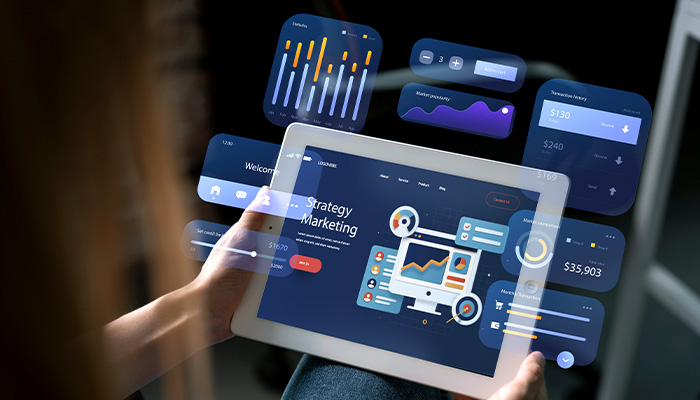How do you Create a Content-Based Recommendation System?

APR, 3, 2024 17:40 PM
How do you Create a Content-Based Recommendation System?
In today's digital age, recommendation systems play a pivotal role in enhancing user experiences across various platforms, from e-commerce websites to streaming services and social media platforms. These systems leverage advanced algorithms to analyse user preferences and behaviours, providing personalised recommendations that cater to individual interests. Among the different types of recommendation systems, content-based recommendation systems stand out for their ability to suggest items based on their attributes and similarities to items users have interacted with or liked.
PerfectionGeeks Technologies is at the forefront of developing cutting-edge recommendation systems, and in this comprehensive guide, we'll delve into the intricacies of creating a content-based recommendation system. We'll explore the fundamental concepts, the key steps involved, and the technologies utilised to build an effective content-based recommendation system that delivers accurate and relevant recommendations to users.
Understanding content-based recommendation systems
Before diving into the technical aspects, it's essential to grasp the underlying principles of content-based recommendation systems. Unlike collaborative filtering methods that rely on user-item interactions and similarities among users, content-based recommendation systems focus on the characteristics or attributes of items themselves.
The core idea behind content-based recommendation systems is to recommend items that are similar to those a user has shown interest in or interacted with in the past. This similarity is determined based on various features or attributes associated with the items. For instance, in the context of a movie recommendation system, the attributes could include genre, actors, directors, ratings, and plot keywords.
By analysing these attributes and comparing them with a user's preferences or historical interactions, content-based recommendation systems can generate personalised recommendations that align with the user's interests. This approach is particularly effective in domains where item attributes play a crucial role in user preferences, such as movies, music, books, and products.
Key Steps in Creating a Content-Based Recommendation System
Building a content-based recommendation system involves several key steps, each of which contributes to the system's effectiveness and accuracy. Let's break down these steps:
Data collection and processing
The first step in creating any recommendation system is gathering relevant data. For a content-based system, this involves collecting data on item attributes or features. In the case of a movie recommendation system, this data may include movie titles, genres, cast and crew information, ratings, release dates, and plot summaries.
Once the data is collected, preprocessing is necessary to clean and format it for analysis. This includes tasks such as removing duplicates, handling missing values, standardising formats, and encoding categorical variables.
Feature Extraction
Feature extraction is a crucial stage where meaningful features are derived from the raw data. In a content-based recommendation system, this involves extracting relevant attributes or features from the items. Techniques such as TF-IDF (Term Frequency-Inverse Document Frequency) for text data, one-hot encoding for categorical variables, and normalization for numerical features are commonly used.
For example, in a music recommendation system, features like genre, artist popularity, tempo, and mood can be extracted from song metadata and user listening history.
Similarity Computation
The cornerstone of content-based recommendation systems is computing similarities between items based on their features. Similarity metrics such as cosine similarity, Euclidean distance, Pearson correlation, and Jaccard similarity are used to quantify the resemblance between items.
For instance, in a movie recommendation system, cosine similarity can be employed to measure the similarity between two movies based on their genre, cast, and plot keywords.
User Profile Creation
To personalize recommendations, a user profile must be created based on the user's historical interactions or preferences. This involves aggregating and summarising the features of items that the user has interacted with or liked. The user profile serves as a representation of the user's interests and informs the recommendation process.
Recommendation Generation
Once the user profile and item similarities are computed, the recommendation generation phase begins. This involves identifying items that are most similar to the user's profile and recommending those items that align with the user's preferences.
Recommendation algorithms such as k-nearest neighbors (k-NN), decision trees, or matrix factorization techniques like singular value decomposition (SVD) can be employed to generate personalized recommendations.
Evaluation and Optimisation
After implementing the recommendation system, it's crucial to evaluate its performance and optimise its effectiveness. Evaluation metrics such as precision, recall, F1 score, and mean average precision (MAP) are used to assess the system's accuracy, relevance, and coverage.
Optimization techniques such as hyperparameter tuning, feature selection, and model fine-tuning are employed to enhance the system's performance and ensure that it delivers high-quality recommendations consistently.
Technologies and Tools for Building Content-Based Recommendation Systems

Building a content-based recommendation system requires a mix of programming languages, libraries, and frameworks tailored to data processing, machine learning, and recommendation algorithms. Here are some key technologies and tools commonly used in developing content-based recommendation systems:
Programming Languages:
Python is widely used for data processing, machine learning, and building recommendation systems due to its rich ecosystem of libraries such as NumPy, Pandas, Scikit-Learn, and TensorFlow.
R is another popular language for statistical computing and machine learning, offering libraries like Caret and recommenderlab for building recommendation systems.
Libraries and Frameworks:
Scikit-learn: A powerful machine learning library in Python that provides tools for data preprocessing, feature extraction, similarity computation, and implementing recommendation algorithms.
TensorFlow and Keras are deep learning frameworks used for building neural network models for recommendation tasks, especially for handling complex data and feature representations.
Surprise: A Python library specifically designed for building recommendation systems offers collaborative filtering and content-based algorithms for recommendation tasks.
NLTK (Natural Language Toolkit): useful for text processing and feature extraction in content-based systems dealing with textual data.
Data Storage and Processing:
MongoDB is a NoSQL database that can store and retrieve item attributes and user preferences efficiently, making it suitable for scalable recommendation systems.
Apache Spark is a distributed computing framework for processing large-scale datasets, enabling faster data processing and model training for recommendation systems.
Amazon S3 or Google Cloud Storage: cloud storage solutions for storing and accessing large volumes of data required for training recommendation models.
Deployment and Scalability:
Docker is a containerisation tool for packaging recommendation system components into containers for easy deployment and scalability.
Kubernetes is a container orchestration platform for managing and scaling containerised applications, ensuring the high availability and performance of recommendation systems.
Best Practices for Building Effective Content-Based Recommendation Systems
While building a content-based recommendation system, certain best practices can enhance its effectiveness and user satisfaction:
Quality Data Collection:Ensure thorough and accurate data collection, including comprehensive item attributes and user interactions, to build a robust recommendation system.
Feature Engineering:Invest time in feature extraction and engineering to derive meaningful features that capture item similarities and user preferences effectively.
Regular Updates:Continuously update the recommendation system with new data and insights to improve recommendations over time and adapt to changing user preferences.
Hybrid Approaches:Consider hybrid recommendation approaches that combine content-based and collaborative filtering methods to leverage the strengths of both techniques for more accurate and diverse recommendations.
Personalisation and Diversity:Balance between personalisation (recommending similar items) and diversity (introducing novel items) to provide a varied yet relevant recommendation experience for users.
Feedback Loop:Incorporate feedback mechanisms such as user ratings, feedback forms, and implicit signals (clicks, views) to iteratively improve recommendation quality and user satisfaction.
Privacy and Ethics:Maintain transparency and ethical guidelines regarding user data usage, ensuring user privacy and trust in the recommendation system.
Case Study: Building a Movie Recommendation System
To illustrate the implementation of a content-based recommendation system, let's consider a case study of building a movie recommendation system using Python and scikit-learn:
Data Collection:Gather a dataset containing movie attributes such as title, genre, cast, director, and plot keywords, along with user ratings or interactions.
Data Preprocessing:Clean the data, handle missing values, and transform categorical variables into numerical representations using one-hot encoding.
Feature Extraction:Extract features from the movie dataset, such as genre vectors, using TF-IDF for text data and encoding other categorical attributes.
Similarity Computation: compute pairwise similarities between movies based on their feature vectors using cosine similarity or other distance metrics.
User Profile Creation:Aggregate movie features based on user ratings or interactions to create user profiles representing their preferences.
Recommendation Generation:Implement a recommendation algorithm (e.g., k-NN) to generate personalised movie recommendations based on user profiles and item similarities.
Evaluation and Optimisation:Evaluate the recommendation system using metrics like precision, recall, and F1 score, and optimise the model parameters for better performance.
By following these steps and leveraging the right tools and technologies, PerfectionGeeks Technologies can build a robust and scalable content-based recommendation system that delivers accurate and personalised recommendations to users across various domains.
Future directions and challenges
As technology continues to evolve, content-based recommendation systems are expected to undergo further advancements and face new challenges. Some future directions and challenges in this domain include:
Deep Learning and Neural Networks:With the growing popularity of deep learning techniques, integrating neural networks for feature representation learning and recommendation tasks can enhance the performance and sophistication of content-based recommendation systems.
Contextual Recommendations:Incorporating contextual information such as user context (location, time, device) and situational context (current activity, mood) can lead to more context-aware recommendations that better align with user needs and preferences.
Cross-Domain Recommendations: exploring techniques for cross-domain recommendations that leverage knowledge transfer and domain adaptation to recommend items from related domains, expanding the recommendation scope and diversity.
Explainability and Transparency:Addressing the challenge of explainability in recommendation systems by developing transparent and interpretable models that provide explanations for recommended items enhances user trust and understanding.
Privacy-Preserving Recommendations:Ensuring privacy and data protection in recommendation systems by implementing privacy-preserving techniques such as differential privacy, federated learning, and secure multi-party computation.
Dynamic and Real-Time Recommendations: adapting recommendation systems to dynamic and real-time environments by incorporating streaming data processing, online learning algorithms, and dynamic user preference modelling.
Ethical Considerations:Navigating ethical considerations and biases in recommendation systems, such as algorithmic fairness, diversity, and unintended consequences, to build responsible and inclusive recommendation solutions.
PerfectionGeeks Technologies: Leading the Way in Recommendation Systems
As a pioneering technology company, PerfectionGeeks Technologies is well-positioned to lead the way in developing innovative recommendation systems that drive personalised user experiences and business success. By leveraging advanced algorithms, cutting-edge technologies, and a deep understanding of user behaviour and preferences, PerfectionGeeks Technologies can create recommendation solutions that exceed user expectations and deliver tangible value to businesses.
With a focus on continuous research, experimentation, and collaboration with domain experts, PerfectionGeeks Technologies can stay ahead of the curve in addressing emerging challenges and opportunities in content-based recommendation systems. By embracing best practices, ethical principles, and user-centric design, PerfectionGeeks Technologies sets a standard of excellence in the field of recommendation systems, shaping the future of personalised digital experiences.
In conclusion, the creation of a content-based recommendation system involves a systematic approach encompassing data collection, preprocessing, feature extraction, similarity computation, user profiling, recommendation generation, evaluation, and optimization. By following best practices, leveraging appropriate technologies, and staying attuned to evolving trends and challenges, PerfectionGeeks Technologies can develop highly effective and impactful recommendation systems that elevate user engagement, satisfaction, and business outcomes.
Strategy
Design
Blockchain Solution
Development
Launching
Testing
Maintenance
Contact US!
India

Plot 378-379, Udyog Vihar Phase 4 Rd, near nokia building, Electronic City, Phase IV, Sector 19, Gurugram, Haryana 122015
Copyright © 2025 PerfectionGeeks Technologies | All Rights Reserved | Policy
Strategy
Design
Blockchain Solution
Development
Contact US!
India 
Plot 378-379, Udyog Vihar Phase 4 Rd, near nokia building, Electronic City, Phase IV, Sector 19, Gurugram, Haryana 122015
USA 
1968 S. Coast Hwy, Laguna Beach, CA 92651, United States
Copyright © 2025 PerfectionGeeks Technologies | All Rights Reserved | Policy




